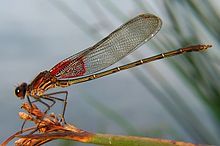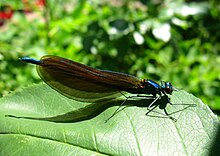Demoiselle
| Demoiselle | ||||||||||||
|---|---|---|---|---|---|---|---|---|---|---|---|---|

Banded demoiselle ( Calopteryx splendens ) on Lake Gülper |
||||||||||||
| Systematics | ||||||||||||
|
||||||||||||
| Scientific name | ||||||||||||
| Calopterygidae | ||||||||||||
| Sélys , 1850 |
The demoiselle (Calopterygidae) are a family of the dragonflies (Zygoptera). They also belong to the dragonflies (Odonata). In Central Europe, two species of this group are known: the banded demoiselle ( Calopteryx splendens ) and the blue-winged demoiselle ( Calopteryx virgo ), in southern Europe there are also the south-western demoiselle ( Calopteryx xanthostoma ) and the bronze demoiselle ( Calopteryx haemorrhoidalis ).
features
The dragonflies are among the largest representatives of the small dragonflies in Europe . They reach a body length of 50 millimeters and a wingspan of 60 to 75 millimeters. The bodies of the European species are all metallic blue-green in color, the males also have striking blue shimmering wings, in the case of the bronze demoiselle they shine copper to bronze brown. The wingtip of the banded dragonfly also remains transparent, so that the species can usually be distinguished at first glance. The females have largely transparent wings and a less noticeably luminous body. The female has a brown band on the wings near the end of the wing of the bronze dragonfly. The flight of the dragonflies is particularly characteristic; it is more like that of butterflies than the typical flight of dragonflies. The wings of these animals have numerous antenodal cross veins. Pterostigmas are absent, but there is a white spot at this point in the females.
Way of life
The dragonflies are mainly residents of slow flowing rivers and streams, in which the larvae of the animals also develop. The resting places are mostly in the direct vicinity of the water, the animals are not very active in flight. Like all dragonflies, they feed on flying insects , although they have no particular specialization.
About two to ten days after hatching from the larval envelope ( exuvia ), the male of the demoiselle occupies a territory for a few days, which it also defends against males of the same species. It marks the area with regular patrol flights and sits with spread wings in exposed areas of the area.
Reproduction
During the mating season, the females ready to mate fly along the waters. The males probably recognize the females by optical characteristics and react to their appearance in the territory with spreading wings. Then the male flies towards the female and accompanies it in a conspicuous fluttering flight . During this flight, it lifts the abdomen, where the light undersides of the last three segments are clearly visible. These are pink in the blue-winged demoiselle, yellowish in the banded demoiselle and the south-western demoiselle. The female then follows the male to the egg-laying site he has chosen. There the female sits down on a water plant while the male hovers back and forth in front of it with the rear end raised. This behavior is followed by the commercial flight in which the male hovers in the air in front of the female and lets the hind wings hang down, as well as the approach to the female.
Mating occurs when the female does not respond by fleeing to the approach of the male. In this case the male lands on the wings of the female and walks on them to the thorax of the female. There it curves the abdomen forward and grips with the forceps formed at the end of the abdomen in special dimples in the prothorax of the female. This is followed by a short tandem flight of the two animals and another landing, with only the male sitting. This pushes the head of the female several times against its copulatory organ in the second abdomen segment, while it bends the abdomen far forward. It then fills the copulatory organ with sperm from the genital opening in the ninth abdominal segment and stretches the abdomen. By pulling movements, the female is induced to turn over her abdomen and so form the mating wheel necessary for copulation . The copulation itself takes about 90 seconds, after which the animals separate. Eggs are laid directly afterwards by piercing the eggs into submerged aquatic plants; it can also happen that the female dragonfly submerges herself. While the eggs are being laid, the male sits nearby and watches over the female.
The adults have an average lifespan of around 30 days.
Larval development
The dragonfly larvae live between aquatic plants in flowing waters. All demoiselle larvae need relatively unpolluted water for their development, whereby the blue-winged demoiselle is somewhat more sensitive than the banded demoiselle. Like all dragonfly larvae, the dragonfly larvae also have three leaf-shaped tracheal gills on their abdomen, which have developed from the cerci and the terminal filum through remodeling .
The larvae are predatory and feed relatively unspecifically on smaller crustaceans , such as the amphipods (Gammaridae) and other insect larvae ( mosquitoes , mayflies, etc.). The prey is primarily perceived visually or by registering water movements. The larvae turn in the direction of their prey and slowly move towards it. The prey is seized by the lower lip, the labium , which has been transformed into a trap mask . After eating the prey, the trap mask is cleaned with the lower legs of the front legs ( tibia ).
The larval development of the demoiselle takes about two years in Central Europe, but can be shortened to one year under optimal conditions. The last moult for the imago takes place outside the water on aquatic plants about 10 to 40 centimeters above the water level.
Systematics

Today around 160 species are counted among the demoiselle, which are assigned to 16 genera:
- Archineura Kirby, 1894
- Atrocalopteryx Dumont, Vanfleteren, De Jonckheere & Weekers, 2005
- Bryoplathanon Garrison, 2006
- Caliphaea Hagen in Selys, 1859
- Calopteryx Leach, 1815
- Echo Selys, 1853
- Hetaerina Hagen in Selys, 1853
- Iridictyon Needham & Fisher, 1940
- Matrona Selys, 1853
- Matronoides Förster, 1897
- Mnais Selys, 1853
- Mnesarete Cowley, 1934
- Neurobasis Selys, 1853
- Noguchiphaea Asahina, 1976
- Ormenophlebia Garrison, 2006
- Phaon Selys, 1853
- Psolodesm McLachlan, 1870
- Sapho Selys, 1853
- Umma Kirby, 1890
- Vestalaria May, 1935
- Vestalis Selys, 1853
The most species-rich genera are Hetaerina with 37 species from the Nearctic and Neotropical , Calopteryx with 29 species in the Palearctic , Indomalayic and Nearctic and Mnesarete with 22 known species in the Neotropical. The sister group of the dragonflies are the Haeterinidae .
supporting documents
- ^ Martin Schorr, Martin Lindeboom, Dennis Paulson: World Odonata List. Update from October 2, 2011 ( download ).
literature
- Heiko Bellmann : Observe dragonflies - determine , Naturbuch Verlag Augsburg, 1993, ISBN 3-89440-107-9
- Buchholz C (1951): Investigations on the dragonfly genus Calopteryx Leach with special consideration of ethological questions Z. Tierpsychol. 8 , 273-293
- Gerhard Jurzitza: The Kosmos Dragonfly Guide , Franckh-Kosmos Verlags GmbH & Co., Stuttgart, 2000, ISBN 3-440-08402-7
- Heymer A (1973): Behavioral studies on dragonflies, contributions to the ethology and evolution of the Calopterygidae , Z. Tierpsychol. Supplement 11 1–100
- Georg Rüppell: Die Prachtlibellen Europa , Die Neue Brehm-Bücherei Volume 654, Westarp Sciences Hohenwarsleben, 2005, ISBN 3-89432-883-5
- Klaus Sternberg, Rainer Buchwald: Libellen Baden-Württemberg , Volume 2, Großlibellen, Eugen Ulmer Verlag, 2000, ISBN 3-8001-3514-0
